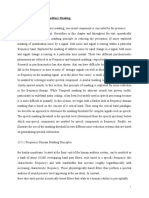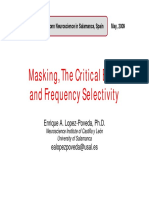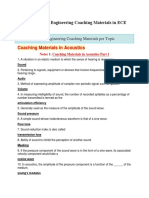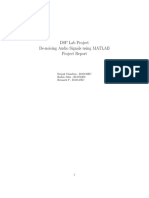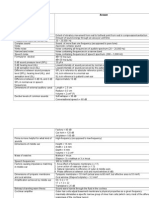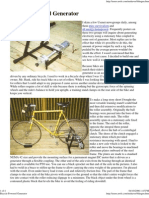Simultaneous Masking
Uploaded by
badshaolinSimultaneous Masking
Uploaded by
badshaolinPresenter:
Bebek Bhattarai
Faculty:
Dr. Vijay Kumar Narne
1
Definition
Everyday situations
Masker--noise
Maskeesignal
Masked threshold
If one freq signal is masked by another frequency masker, then it indicates poor
frequency because the system is not able to resolve the two freq separately.
Simultaneous masking
Non-simultaneous
2
Frequency selectivity.
Filters in the cochlea.
What happen when there is damage to OHC???
Reduced sharpness of Tuning Curves of BM and single neuron.
3
How do we measure it
Detection of a fixed freq signal in presence of masker
It is based on two concepts
Auditory filter shape
Excitation pattern
4
Fletcher (1940)
Cochlea as array of bandpass filters with overlapping
passband filter
Filters corresponds to particular place in BM
5
Array of linear overlapping filters
In noisy situation, only on filter is used; which has
maximum SNR and freq close to signal
Only the noise in the filter will have effect,
detection is dependent on the level of noise in that
filter
6
Non-linear filter which are level dependant
Information can be combined from diff filters
Noise outside of band also affects the
detection
Fluctuation (short) of noise can affect
detection
7
1:
Signal at fixed intensity and freq
Masker of diff freq
Find detection level
Plot gives shape of filter
2:
Signal whose freq are systematically
changed
Input changed so as to keep o/p
constant
8
Maxima at CF Minima at CF
If the filter is linear
Auditory filters are not linear
It is level dependent; shape changes with level
Also filter shape depends on whether i/p or o/p is held constant.
Practically it is difficult, we can jus approximate
Measure i/p and o/p is difficult in human.
Hence filter shapes are obtained using masking methods following the assumptions
stated earlier.
9
PTC
Similar to tuning curve of BM or single neuron
Signal fixed at low level, usually 10dBSL
Masker can be NBN or sinusoidal signal (noise preferable)
Reduced formation of beats
With sinusoid beats can give cues about the presence of signal. Resulting PTC can be sharper than
the exact curve
Masker at diff freq presented
Level of masker required to just mask the signal is found out
Since signal at low level (10dBSL), it is assumed that:
Masker produces constant o/p at single filter
As low level only one filter is involved
10
11
Off-frequency listening
Affects the PTC
If masker above the signal, maximum SMR at lower level than the
signal frequency
If masker is below signal freq, maximum SMR is obtained for freq
above signal freq
Because the PTC have rounded peaks
12
Solution for off- freq listening would be notch noise
Here the procedure is similar, as finding threshold in
presence of noise; but the notch noise will be constantly
present
Notch noise reduced the off freq listening when freq shifts
occurs.
13
14
15
With notch noise technique
Either the signal can be kept constant or the masker
can be kept constant
Usually noise level is kept constant
16
17
In notch noise techniquie:
If the threshold drops rapidly with increasing the notch
width, it indicated sharply tuned freq curve
Whereas if the drop is slow,it indicates broadly tuned curve
Also with the relation between the noise and the threshold,
the action of the filter can also be determined.
18
19
Notch noise technique does not yield better
representation of tuning curve if the filter is not
symmetric, as in:
Hearing loss cases
High intensity level (only at moderate level the filter is
symmetric)
At high intensity level the notch should also be placed
asymmetrically to get valid result.
20
VARIATION WITH CENTER FREQUENCY
Bandwidth
-3dB bandwidth or half power bandwidth
ERB (Equal Rectangular Bandwidth)
{for auditory filters: ERB is 11% larger than -3dB bandwidth}
21
22
F= CF
N= For Normal Hearing
For normal listeners, the filter is relatively constant
except for very low and high frequencies.
Each ERB
N
corresponds to about 0.89mm on BM.
Normal variation is not more than 10% from mean of
ERB
N.
23
VARIATION WITH LEVEL:
Since filters are non-linear, there will be difference in the filter
with diff level.
If it was liner then the filters would have been symmetrical at all
levels
24
Studied with notch noise---symmetrical and assymetrical
Findings:
The slope of LF becomes less sharper at higher level
HF become more steeper at high level
25
The concluded as:
Filter at 1KHz is symmetrical at moderate intensity of noise
(30dB)
For other freq also symmetrical if the i/p level is 51dB/ERB
N
at
1KHz
Low freq side become less steep with increasing intensity
High freq side variable results:
@ 1-4KHz: slope increases with intensity
@ High CF slope decreases with increasing intensity
26
27
28
Conductive hearing loss (Hg loss varies at diff freq)
Shift in threshold (with noise should be present)
SPL or SL used to compare Normal and HI
If SPL, TW at BM will be equal
If Sl, the SPL at BM will be diff.
Amount of masking or masked threshold
Diff level of hearing requires diff level to get masked
29
30
Differential Diagnosis:
Langenbeck (1950) studied on normal listeners, listeners
with noise induced hearing loss, with head injury and with
presbyacusis.
Normal: comparative shift in threshold across freq
NIHL: similar to normal at LF; at HF elevated due to hg loss
Presbyacusis: abnormal shift above 1.5KHz
Head injury: abnormal across freq
But no clear cut demarcation obtained
Noise was presented at 40dB SPL.
31
Palva et al (1953) studied masking of pure tone using
broadband noise in normal, SN hearing loss with
recruitment and SNHL without recruitment.
No significant difference among group data in terms of
masked thresholds.
The levels of noise presentation were 40, 50& 60 dB SPL.
32
Lightfoot et al (1956):
BBN at 60 & 80 dB SPL in 30 hearing impaired subjects and at 80 &
95 dB SPL in another 30.
They found that the elevation in masked thresholds in SN HL group
was at least 10 dB above than normal at frequencies 2000Hz and
above whereas it was less than 10 dB in conductive hearing loss.
Significant variation within group.
33
Webster et al (1950) masked threshold increased by1 dB
for every 10 dB absolute threshold elevation above normal
(0 dB HL).
Higher masked thresholds in females, above 40 years
and those without musical training.
Suggested elevated masked thresholds could be an
indicator of wide critical bandwidth and poor frequency
resolution.
34
Tyler et al (1982) reported more masking than normal for
low level of noise but had normal masked threshold at
high noise levels in two hearing impaired.
This could be
Frequency resolution is better at high intensity in hearing
impaired, which contradicts to normal (Scharf et al 1977),
Change in efficiency of the detector mechanism.
35
Filter shape or detector mechanism
Elevated threshold in noise due to widened auditory filter or
less effective detector mechanism.
Tyler et al (1982) suggested that the nonlinear growth of
masking might also be better understood in terms of changes in
the detector mechanism.
36
Watson and Tolan (1949) used tone on tone masking with a combination of 250/1000,
500/2000, 1000/3000 as masker/signal respectively in individuals with hearing
impaired.
The presentation level was increased gradually in 10 dB steps and reported that
four subjects did show a less change in signal threshold with increase in masker
level.
At the same time de Bruine-Altes (1949) reported higher than normal masked
thresholds at signal frequencies of 2000 and 4000 Hz for a 400 Hz masker.
37
Tyler et al (1980) reported that pronounced upward spread
of masking is generally confined to the regions of
absolute threshold loss
38
Leshowitz et al (1975) and Carney and Nelson (1976)
Normal sharply tuned PTCs in regions of normal absolute
thresholds
Abnormal broadly tuned PTCs in regions of elevated
absolute thresholds
Correlation between threshold and the sharpness of tuning
varies markedly across studies
No systematic differences in PTCs have been reported
between cochlear losses of different origin, such as noise
induced, Menieres disease, ageing, and hereditary losses.
39
Carney and Nelson (1983): Compared simultaneous tuning
curves from normal-hearing and hearing-impaired listeners
using probe tones that were either at similar SL's or at
similar sound pressure levels for both types of listener.
40
41
42
Tuning curves from the hearing-impaired listeners are flat,
erratic, broad, and/or inverted, depending upon the
frequency region of the probe tone and the frequency
characteristics of the hearing loss.
43
44
Similar manner to analogue filters
Q10dividing the signal frequency by the bandwidth
measured 10 dB up from the tip.
Bonding (1979) has chosen a slightly different approach.
His measurement of tuning is defined as the distance in
dB between the tip of the PTC and the level where the
PTC is 1 octave wide..
45
Tyler et al (1979) quantified the high and low
frequency slopes of the PTCs to find asymmetries.
Slope calculated between two masker freq.
Which might not give better representation.
It might be misleading if we are evaluating W-shaped
PTC
Low freq more curvilinear.
46
Tyler et al (1983) used a tip-to-tail difference score
(the difference between masker level in the tail of
the PTC and the masker level at the tip of the
PTC).
Used to quantify the efficiency of the detector
mechanism (cochlear amplifier).
Stelmachowitz, et al. (1985): Compared Q10 and
concluded abnormal upwards spread of masking
in HI.
47
Davidson & Melnick (1988):
Compared PTCs in simultaneous masking using 2
methods:
2 IAFC (transformed up down procedure)
Bekesy tracking
More masking seen in the Bekesy method which
could be because of subjects criteria for threshold.
May be due to lack of choice (no force choice)
48
Problem for both quantification and interpretation of PTCs.
Possibility is that some form of temporal interaction between
the masker and the signal is being detected
Viemeister suggested that these listeners may be hearing a
modulation or beating over an extended frequency range.
Off frequency listening
49
Leshowitz and Lindstrom (1977) noted that in one
listener with a NIHL, 68 dB SPL 4800 Hz masker as
sufficient to mask a 75 dBSPL 5400 Hz signal.
This was called over masking.
Hoeksta (1979) noted that in some cases masker level
may be 20 dB less than the signal level.
50
Beats
Off frequency listening
Comparison between normal and HI
51
A brief signal is more easily masked when presented at
the onset of masker rather than temporal center for a
long duration masker.
In this case, more masking takes place and hence PTCs
tip gets broader, if at onset.
52
PTCs were sharpest when the signal was at the temporal
center of the masker, and broadest when it was at the
beginning of the masker
53
PTC was virtually independent of the temporal position
of the signal
Reason may be:
Mechanisms responsible for sharpening the PTC with
time in normal-hearing listeners are ineffective in
listeners with moderate-to-severe sensorineural hearing
loss
54
Normal Hearing Hearing Impaired
55
Auditory filter becomes more highly tuned with time after
onset of stimulation.
The spectral splatter occurring at the onset of a masker
causes a transient increase in masking.
The neural adaptation accounts for the phenomenon
56
Reduced cochlear gain leads to elevated thresholds
Steeper input-output functions lead to steeper
growth of loudness level
Broader cochlear tuning leads to poorer frequency
selectivity.
57
58
You might also like
- The Physics and Technology of Diagnostic Ultrasound: Study Guide (Second Edition)From EverandThe Physics and Technology of Diagnostic Ultrasound: Study Guide (Second Edition)No ratings yet
- Looking For Cochlear Dead Regions A Clinical Experience With TEN TestNo ratings yetLooking For Cochlear Dead Regions A Clinical Experience With TEN Test9 pages
- Fundamentals of Sound Quality: Dr. Arunkumar M. SampathNo ratings yetFundamentals of Sound Quality: Dr. Arunkumar M. Sampath32 pages
- Threshold Equalizing Noise (TEN) - Quick Guide: What Is The TEN Test?No ratings yetThreshold Equalizing Noise (TEN) - Quick Guide: What Is The TEN Test?3 pages
- Tests To Diagnose Dead Regions in Cochlea-AgNo ratings yetTests To Diagnose Dead Regions in Cochlea-Ag37 pages
- Objective Method For Assessing The Audibility of Tones in Noise Joint Nordic MethodNo ratings yetObjective Method For Assessing The Audibility of Tones in Noise Joint Nordic Method18 pages
- WHITHER DITHER: Experience With High-Order Dithering Algorithms in The StudioNo ratings yetWHITHER DITHER: Experience With High-Order Dithering Algorithms in The Studio21 pages
- Human Factors Course Lec14 Sound ExposureNo ratings yetHuman Factors Course Lec14 Sound Exposure43 pages
- New Method For The Measurement of Nonlinear DistortionNo ratings yetNew Method For The Measurement of Nonlinear Distortion17 pages
- Sound Is A Sensation of Acoustic Waves (Disturbance/pressure Fluctuations Setup in A Medium)No ratings yetSound Is A Sensation of Acoustic Waves (Disturbance/pressure Fluctuations Setup in A Medium)31 pages
- Psychophysical Tuning Curves For Frequencies Below 100 HZNo ratings yetPsychophysical Tuning Curves For Frequencies Below 100 HZ15 pages
- An Adaptive Noise Reduction Stethoscope For Auscultation in High Noise EnvironmentNo ratings yetAn Adaptive Noise Reduction Stethoscope For Auscultation in High Noise Environment9 pages
- Masking Frequency Selectivity and The Critical BandNo ratings yetMasking Frequency Selectivity and The Critical Band80 pages
- A Study On Impact of Tinnitus Masking On PsychophyNo ratings yetA Study On Impact of Tinnitus Masking On Psychophy11 pages
- The Scientist and Engineer's Guide To Digital Signal Processing by Steven W. Smith, PH.DNo ratings yetThe Scientist and Engineer's Guide To Digital Signal Processing by Steven W. Smith, PH.D9 pages
- MTPPT1 PrinciplesofEngineeringAcousticsNo ratings yetMTPPT1 PrinciplesofEngineeringAcoustics57 pages
- Communication Theory Question Bank Unit 4No ratings yetCommunication Theory Question Bank Unit 42 pages
- m Noise Measuring Sound Level PotentialsNo ratings yetm Noise Measuring Sound Level Potentials8 pages
- Data Sheet 6ES7152-1AA00-0AB0: Input CurrentNo ratings yetData Sheet 6ES7152-1AA00-0AB0: Input Current2 pages
- Data Acquisition: Reference Book Jovitha Jerome, "Virtual Instrumentation and LABVIEW", PHI LearningNo ratings yetData Acquisition: Reference Book Jovitha Jerome, "Virtual Instrumentation and LABVIEW", PHI Learning40 pages
- Implementation of High Speed and Low Power 5T-TSPC D Flip-Flop and Its ApplicationNo ratings yetImplementation of High Speed and Low Power 5T-TSPC D Flip-Flop and Its Application5 pages
- ImprovedSuper RegenerativeReceiverTheoryNo ratings yetImprovedSuper RegenerativeReceiverTheory12 pages
- E-1778 - Auxiliary Feathering Pump AFP-28No ratings yetE-1778 - Auxiliary Feathering Pump AFP-288 pages
- Wiring Instructions For Marley 2500 Series Electric Baseboard Heaters XNo ratings yetWiring Instructions For Marley 2500 Series Electric Baseboard Heaters X7 pages
- Fessler - 2010 - Model-Based Image Reconstruction For MRINo ratings yetFessler - 2010 - Model-Based Image Reconstruction For MRI9 pages
- Pneumatic Tension Control System MCS-166/MCS-207/MCS-208: Installation & Operating InstructionsNo ratings yetPneumatic Tension Control System MCS-166/MCS-207/MCS-208: Installation & Operating Instructions26 pages
- The Physics and Technology of Diagnostic Ultrasound: Study Guide (Second Edition)From EverandThe Physics and Technology of Diagnostic Ultrasound: Study Guide (Second Edition)
- Looking For Cochlear Dead Regions A Clinical Experience With TEN TestLooking For Cochlear Dead Regions A Clinical Experience With TEN Test
- Fundamentals of Sound Quality: Dr. Arunkumar M. SampathFundamentals of Sound Quality: Dr. Arunkumar M. Sampath
- Threshold Equalizing Noise (TEN) - Quick Guide: What Is The TEN Test?Threshold Equalizing Noise (TEN) - Quick Guide: What Is The TEN Test?
- Objective Method For Assessing The Audibility of Tones in Noise Joint Nordic MethodObjective Method For Assessing The Audibility of Tones in Noise Joint Nordic Method
- WHITHER DITHER: Experience With High-Order Dithering Algorithms in The StudioWHITHER DITHER: Experience With High-Order Dithering Algorithms in The Studio
- New Method For The Measurement of Nonlinear DistortionNew Method For The Measurement of Nonlinear Distortion
- Sound Is A Sensation of Acoustic Waves (Disturbance/pressure Fluctuations Setup in A Medium)Sound Is A Sensation of Acoustic Waves (Disturbance/pressure Fluctuations Setup in A Medium)
- Psychophysical Tuning Curves For Frequencies Below 100 HZPsychophysical Tuning Curves For Frequencies Below 100 HZ
- An Adaptive Noise Reduction Stethoscope For Auscultation in High Noise EnvironmentAn Adaptive Noise Reduction Stethoscope For Auscultation in High Noise Environment
- Masking Frequency Selectivity and The Critical BandMasking Frequency Selectivity and The Critical Band
- A Study On Impact of Tinnitus Masking On PsychophyA Study On Impact of Tinnitus Masking On Psychophy
- The Scientist and Engineer's Guide To Digital Signal Processing by Steven W. Smith, PH.DThe Scientist and Engineer's Guide To Digital Signal Processing by Steven W. Smith, PH.D
- The Music Producer's Guide To EQ: The Music Producer's GuideFrom EverandThe Music Producer's Guide To EQ: The Music Producer's Guide
- Data Acquisition: Reference Book Jovitha Jerome, "Virtual Instrumentation and LABVIEW", PHI LearningData Acquisition: Reference Book Jovitha Jerome, "Virtual Instrumentation and LABVIEW", PHI Learning
- Implementation of High Speed and Low Power 5T-TSPC D Flip-Flop and Its ApplicationImplementation of High Speed and Low Power 5T-TSPC D Flip-Flop and Its Application
- Wiring Instructions For Marley 2500 Series Electric Baseboard Heaters XWiring Instructions For Marley 2500 Series Electric Baseboard Heaters X
- Fessler - 2010 - Model-Based Image Reconstruction For MRIFessler - 2010 - Model-Based Image Reconstruction For MRI
- Pneumatic Tension Control System MCS-166/MCS-207/MCS-208: Installation & Operating InstructionsPneumatic Tension Control System MCS-166/MCS-207/MCS-208: Installation & Operating Instructions








